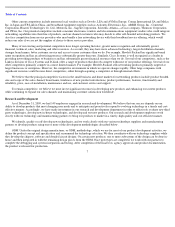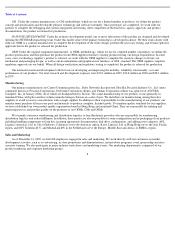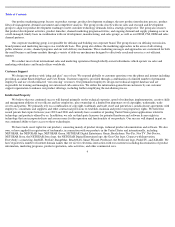Netgear 2009 Annual Report Download - page 19
Download and view the complete annual report
Please find page 19 of the 2009 Netgear annual report below. You can navigate through the pages in the report by either clicking on the pages listed below, or by using the keyword search tool below to find specific information within the annual report.
Table of Contents
compliance process to ensure that we and our suppliers are in compliance with all existing regulations. There are areas where future regulations
may be enacted which could increase our cost of manufacture. One area which has a large number of potential changes in regulations is the
environmental area. Environmental areas such as pollution and climate change have had significant legislative and regulatory efforts on a global
basis, and there are expected to be additional changes to the regulations in these areas. These changes could directly increase the cost of energy
which may have an impact on the way we manufacture products or utilize energy to produce our products. In addition, any new regulations or
laws in the environmental area might increase the cost of raw materials we use in our products. While future changes in regulations appears
likely, we are currently unable to predict how any such changes will impact us and if such impacts will be material to our business. If there is a
new law or regulation that significantly increases our costs of manufacturing or causes us to significantly alter the way that we manufacture our
products, this would have a material adverse affect on our business, financial condition and results of operations.
We are currently involved in various litigation matters and may in the future become involved in additional litigation, including
litigation regarding intellectual property rights, which could be costly and subject us to significant liability.
The networking industry is characterized by the existence of a large number of patents and frequent claims and related litigation regarding
infringement of patents, trade secrets and other intellectual property rights. In particular, leading companies in the data communications markets,
some of which are competitors, have extensive patent portfolios with respect to networking technology. From time to time, third parties,
including these leading companies, have asserted and may continue to assert exclusive patent, copyright, trademark and other intellectual
property rights against us demanding license or royalty payments or seeking payment for damages, injunctive relief and other available legal
remedies through litigation. These include third parties who claim to own patents or other intellectual property that cover industry standards that
our products comply with. If we are unable to resolve these matters or obtain licenses on acceptable or commercially reasonable terms, we could
be sued or we may be forced to initiate litigation to protect our rights. The cost of any necessary licenses could significantly harm our business,
operating results and financial condition. Also, at any time, any of these companies, or any other third party could initiate litigation against us, or
we may be forced to initiate litigation against them, which could divert management attention, be costly to defend or prosecute, prevent us from
using or selling the challenged technology, require us to design around the challenged technology and cause the price of our stock to decline. In
addition, third parties, some of whom are potential competitors, have initiated and may continue to initiate litigation against our manufacturers,
suppliers, members of our sales channels or our service provider customers, alleging infringement of their proprietary rights with respect to
existing or future products. In the event successful claims of infringement are brought by third parties, and we are unable to obtain licenses or
independently develop alternative technology on a timely basis, we may be subject to indemnification obligations, be unable to offer competitive
products, or be subject to increased expenses. Finally, consumer class-action lawsuits related to the marketing and performance of our home
networking products have been asserted and may in the future be asserted against us. For additional information regarding certain of the lawsuits
in which we are involved, see the information set forth under Note 9 of the Notes to Consolidated Financial Statements in Part I, Item 1 of this
report, which information is incorporated into this Item 1A by reference. If we do not resolve these claims on a favorable basis, our business,
operating results and financial condition could be significantly harmed.
If our products contain defects or errors, we could incur significant unexpected expenses, experience product returns and lost sales,
experience product recalls, suffer damage to our brand and reputation, and be subject to product liability or other claims.
Our products are complex and may contain defects, errors or failures, particularly when first introduced or when new versions are released.
The industry standards upon which many of our products are based are also complex, experience change over time and may be interpreted in
different manners. Some errors and defects may be discovered only after a product has been installed and used by the end-user. For example, in
January 2008, we
17
























